- 1. What is gravel and where is it used in construction?
- 2. Gravel and Crushed Stone Foundation – A Distinctive Feature of Construction
-
3.
DIY Gravel Placement for the Foundation
- 3.1. Measurements and Preliminary Calculations
- 3.2. Marking
- 3.3. Preparation for Trench Excavation and Layer Placement
- 3.4. Possible Errors in Gravel Layer Placement and How to Avoid Them
- 3.5. Advantages and disadvantages of using gravel in the foundation as a top layer and inside the pie
- 3.6. Conclusion
The use of a gravel soft landscaping is an inexpensive and easy way to remove rainwater and meltwater. Building it does not require special knowledge, qualifications, or experience in such work. To construct this type of landscaping, one needs the necessary tools, materials, and recommendations from specialists. We will discuss in detail what a gravel soft landscaping is, how to make it of good quality, and what is required for this in our article.
What is gravel and where is it used in construction?
Gravel is a coarsely fragmented mountain rock obtained by an open method with a smooth surface and a variety of shades. However, gravel should not be confused with crushed stone. They differ in the method of extraction, but their sphere of application is approximately the same.

Different types of gravel differ in strength, hardness, and frost resistance. The selection of gravel for soft landscaping depends on various factors such as the region’s temperature conditions, the structure type, and financial considerations. The appropriate material with the necessary parameters is chosen according to the specific application.
To make soft landscaping, one must choose gravel of medium and small fractions. Large fractions are not used in this type of work. Depending on the fraction, the material has different properties, including:
- Fine fraction. It is easy to tamp, which is an important property when making soft landscaping;
- Medium fraction. It looks more aesthetic when filled, and its more affordable price makes it an indispensable material in construction. To save money, specialists mix it with fine fraction gravel.
- Gravel soft landscaping is recommended for small residential houses. Despite its low strength characteristics (compared to granite or concrete landscaping), it is an excellent material for cottages and private houses.
- Soft landscaping is used in areas where the water level in the soil is high and regularly floods it. Gravel is used for such landscaping, as it copes well with its task and removes excess moisture from the foundation.
Important! When making a gravel or stone landscaping around the house, it is important not to forget about organizing drainage. This will allow for less frequent repair work.
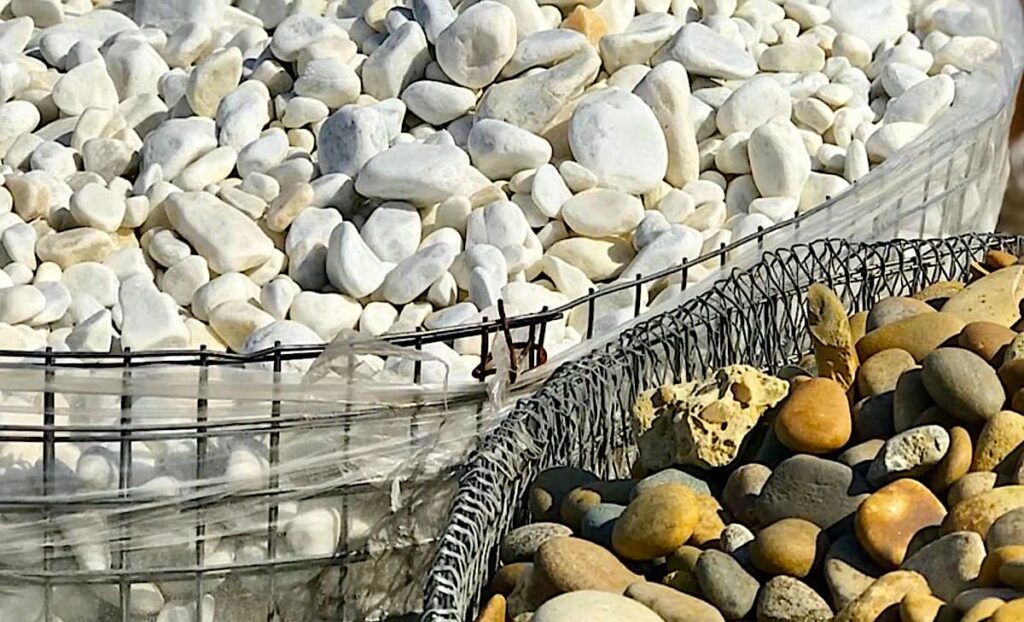
Gravel of any color can be used to organize landscaping around the house. Gravel has an aesthetic, impressive appearance, which is why designers like to use it for creating flower beds, garden paths, and artificial ponds. Its attractive appearance is not due to mechanical crushing on machines, but due to natural rock erosion. As a result, the stones have a smooth surface, natural shape, and different colors.
Gravel and crushed stone have high indicators of frost and moisture resistance.
Gravel and Crushed Stone Foundation – A Distinctive Feature of Construction
A soft landscaping is a multi-layer cushion with a layer of gravel on top. Its advantages are its low cost and the possibility of doing all the work yourself, without spending money on hiring specialists. However, its average service life is no more than 7 years. Despite this, this type of construction is used in different regions with different climates, and there are no restrictions on its use depending on the soil composition.
Requirements for gravel for landscaping construction:
- High strength indicators;
- Moisture resistance;
- Good heat-insulating properties;
- Attractive appearance;
- Preservation of its initial properties throughout the entire service life;
- Resistance to ultraviolet radiation;
- Frost resistance;
- Good tolerance to sudden changes in the external environment temperature;
- Affordable price.
If the requirements for the construction are violated, it will not function as it should, which will lead to erosion and premature destruction of the foundation, garden beds, and paths.
Rules for laying the gravel layer in the foundation
The foundation is a multi-layered pie consisting of:
- Clay, which serves as a cushion;
- Waterproofing, which is laid with roofing material, PVC film;
- Sandy, consisting of large-grained sand that serves as drainage;
- Geosynthetic, which has protective functions and prevents gravel from sinking and weeds from sprouting;
- Gravel layer, the top layer of the foundation.
What consumables and tools are needed for laying
Before purchasing consumables, preliminary calculations are necessary to avoid unnecessary purchases. After calculating the area of the foundation, you need to buy gravel, clay, sand, waterproofing and geosynthetic materials, and sealant for sealing joints.
Tools that may be required include an inclinometer, metal rods, rope, shovel, tamper, and a knife for cutting the waterproofing material to the required size.
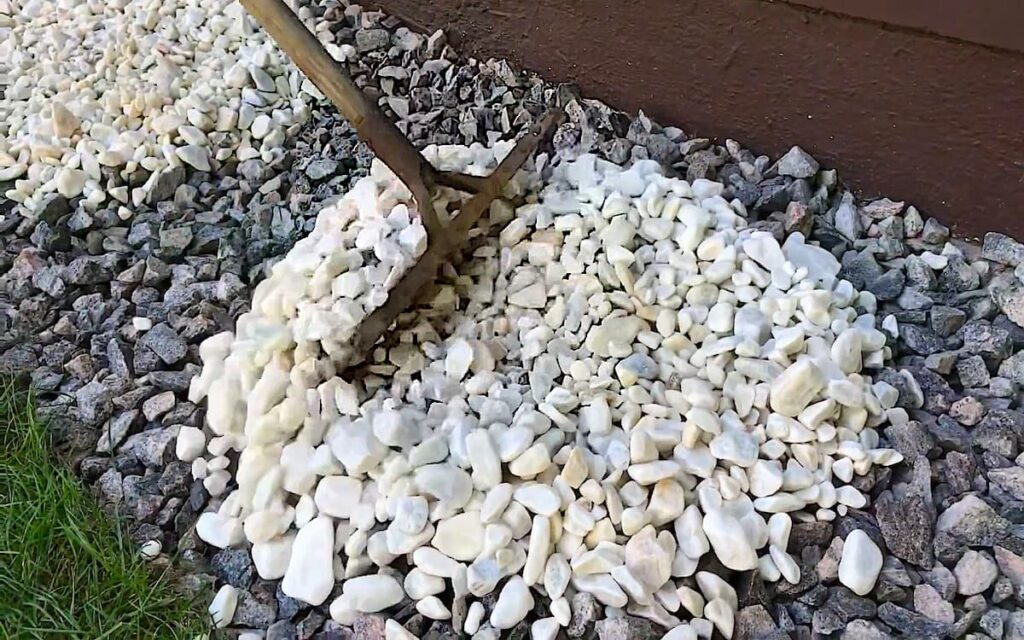
Note that the above is an approximate list of tools and materials needed for the foundation. Each builder determines the necessary tools for themselves.
DIY Gravel Placement for the Foundation
Measurements and Preliminary Calculations
Before constructing the foundation, it is important to calculate the required materials in order to avoid unnecessary trips to the store and additional expenses due to lack of attention to detail. To do this, the length, height, and depth of the foundation are measured and multiplied together. This will allow you to calculate the amount of building materials that will need to be purchased from the store.
Marking
During this stage, measurements of the roof overhang and soil type are taken. After the calculations are made, it is recommended to place stakes and stretch a string around the perimeter of the private cottage. A waterproof membrane can help prevent water stagnation.

Preparation for Trench Excavation and Layer Placement
The following steps are taken:
- The top layer of soil is removed from the marked area according to the calculations. The bottom is leveled well;
- A layer of clay is laid and then compacted tightly;
- A waterproofing material is rolled out with overlapping seams, and the seams are sealed with a bitumen-based compound;
- If thermal insulation is needed, the trench is lined with foam polystyrene, and the connecting seams are sealed with sealant. The material is then covered with a thick polyethylene film;
- The layer of sand is leveled and compacted firmly. A membrane layer is then added to reduce gravel settling, followed by a layer of gravel that is compacted for density.
Gravel is used not only as the top layer for soft foundation filling but also internally. The internal layer of gravel serves the purpose of additional soil compaction, good drainage material, and as an additional foundation insulator. In this case, the gravel layer in the foundation comes after the sand layer.
Possible Errors in Gravel Layer Placement and How to Avoid Them
To avoid mistakes in construction and prevent the need for rework, it is important to understand how professionals perform this work:
- To effectively divert excess water from the structure, all layers should be sloped. Water will flow through the gravel and sand according to the slope on the waterproof clay layer.
- The foundation should be tightly joined to the gravel layer to prevent water from seeping into the space between it and the foundation. Otherwise, in winter, water will freeze and increase the gap, leading to the destruction not only of the gravel layer but also of the entire house.
- The gravel layer should be installed no later than one year after foundation work. Groundwater should be no closer than one meter to ensure proper drainage of excess moisture.

Advantages and disadvantages of using gravel in the foundation as a top layer and inside the pie
Advantages of gravel material:
- Reliable protection of the foundation from excess moisture and better thermal insulation properties;
- It has high strength and resistance to environmental factors. There is no soil settling or damage to the structure due to its soft structure;
- Affordable prices. All work can be done without hiring specialists. Simple construction work;
- Versatility and possibility of use for any type of foundation (strip, pile, columnar, monolithic);
- Ability to realize various design projects due to the wide variety of stores, choices for different tastes and colors. Plants can be planted on such a foundation.
Disadvantages may include:
- A complicated cleaning process from dirt, debris, and leaves;
- Over time, weeds will start to grow through the gravel, spoiling the overall appearance;
- Minimum service life is no more than 7 years.

Conclusion
Making a gravel foundation by yourself is an easy task that can be accomplished by a beginner builder without sufficient experience and knowledge. By following the requirements for calculating the parameters of the object, you can make a foundation around the house in a weekend, thus preventing its foundation from premature destruction.
Creating a foundation around the house not only insulates and waterproofs the foundation from excess moisture, which is relevant in autumn and spring periods but also gives the building a well-maintained appearance.
With the help of a foundation, you can create a designer exterior for the yard, improve the territory without investing a lot of money. By following construction standards and rules, you can build a house that will last for decades without the need for additional repairs.
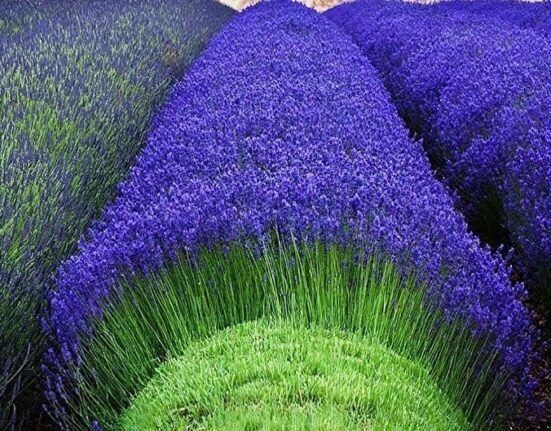

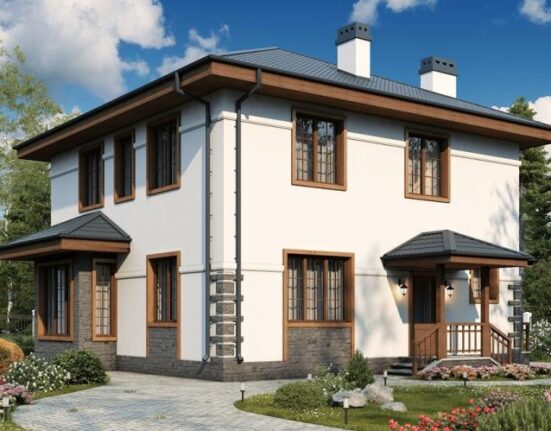

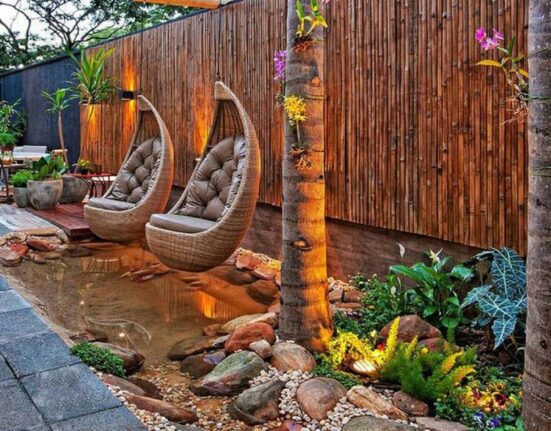
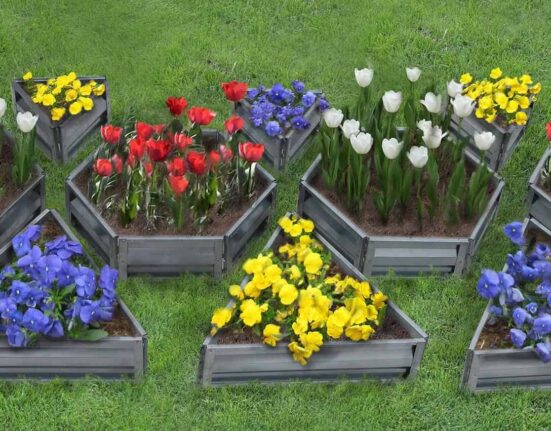
Leave feedback about this